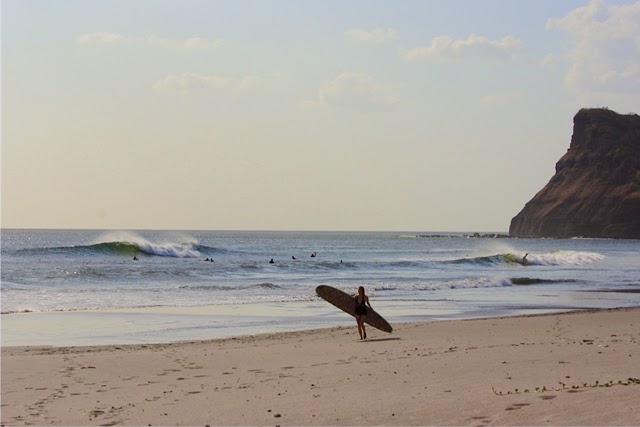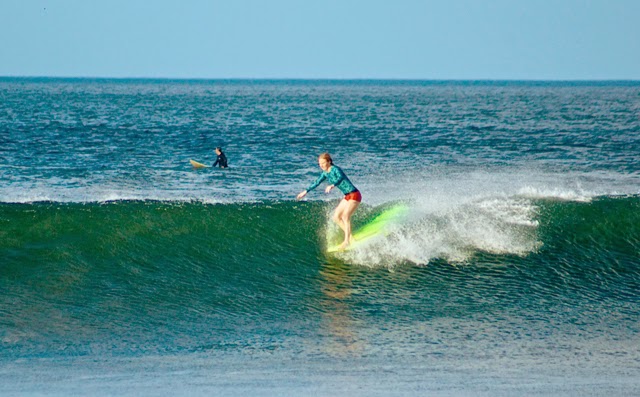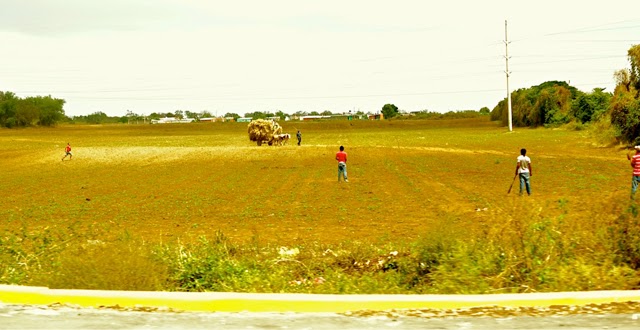 |
| Amy Reda after a sun-soaked session in Nicaragua. Photo by Tim Reda. |
The benefits of summer surf camp — friendship bonding, nonstop fun, organized activities — doesn’t have to be lost forever past graduation age. When you are a high school surf coach like Amy Reda, you get to enjoy an eternal youth of awesome surf team trips like her most recent one to Nicaragua’s peaky waves with a beautiful view of cactus-lined hills in the background.
Between three to five (!) daily surf sessions coaching the girl’s Newport Harbor High School surf team, Amy still squeezed in floating in the infinity pool, hiking, climbing trees for coconuts, yoga, bocci ball and laying on the beach and watching the star-filled sky during her recent trip.
 |
| Amy Reda finds a fun wave on her longboard in the Swami's. Photo by Tim Reda. |
Now in her third year of being coach and second year traveling to Mark & Dave’s surf and yoga retreat in Nicaragua, (not to mention all the countless lessons she gives as owner of Endless Sun Surf School in Newport Beach and personal surf trips around the world) we asked Amy how she prepares her students for international travel and the common misconceptions about surfing in a bikini!
 |
| Driving through town in Nicaragua. Photo by Tim Reda. |
People are sometimes afraid of general safety when traveling Nicaragua. For several different reasons, I feel much safer in Nicaragua than I do in Costa Rica. If you're at Mark & Dave's, you should never have to be too concerned, being in a gated beach community. Just don't eat the Manzanita de Muerto (Apple of Death) that lives behind the resort. The fruit looks really tasty and tempting to eat but its poisonous. Last year Tim and a student took a bite and got a little sick. One of the new chefs also ate the fruit and went to the hospital. The smoke from the burning wood will make you blind, and the sap will eat holes through your skin!
 |
| Ladies carrying baskets. Photo by Tim Reda. |
For your students (or anyone) traveling to Nicaragua for the first time, what’s important to recognize about the culture?
I think traveling to Nicaragua is an eye-opener for many students coming from Orange County. Nicaragua is the second poorest country in the Western Hemisphere. In contrast, Orange County is one of the wealthiest places in the world. When we drive from the airport to Mark & Dave’s, the kids can see that many homes are the equivalent size of their bedrooms. Animals and people roam the streets in search of handouts. We gave an elderly woman five dollars and she looked as if she'd just won the lottery. The streets are lined with garbage. One of my surf students, Tehya Corona, was trying to think of a way to turn the country's trash problem into a recycling business that the Nicaraguans could profit off of.
 |
| Kids play in one of the local fields. Photo by Tim Reda. |
What were some of the things you did to help?
Kimmi, the yoga instructor at Mark & Daves, told me that Nicaragua has one of the highest infant mortality rates, and it's mostly due to unclean water. We brought over water filters from Waves For Water. Hopefully this will help some people in Nicaragua, and it will help our students see how easy it is to lend a helping hand.
We have a group of great kids on our team, and many of them already know the harsh realities of the world. But many of them have never traveled outside of the country, so it's good for them to experience what happens outside of our Orange County bubble.
 |
| Amy hits the lip. Photo by Tim Reda. |
 |
| Amy ready to duck dive and shred in the Swami's. Photo by Tim Reda. |
What are the waves like in Nicaragua?
Mark & Dave’s is in front of Panga Drops, a fun solid wave that breaks on all tides, all swells and all times of the year. It's a deep-water wave, a few hundred meters out to sea, and it’s surrounded by trees, jungle and cactus-lined hills. It holds big swell and creates sizeable, long running walls. [Nicaragua’s unique location is known for consistent surf and nearly always offshore winds].
 |
| Amy tests out a Seea prototype neoprene jacket and the Calafia surf leggings. Photo by Tim Reda. |
What are the common mistakes that you see women make in their surfsuit choices?
You may think that you want to wear a bikini the entire time on your surf trip, but many barriers may conflict with that. Bring a rashguard, wetsuit jacket, and surf leggings with you to your “warm” destination. If you want to maximize your time in the water, you need things to protect you against board rash, wind chill, sunburn, perverts, and things that sting, like jelly fish. I've seen girls get out of the water and cut their session unnecessarily short because they chose to wear a bikini.
I was literally surfing in my Seea suits from sunrise to sunset. Most days we would surf three to five different sessions. If I wasn’t surfing, I was wearing my Seea leggings and bikini top to yoga and meditation classes. A few days I went hiking on the beach and in the hills in my Swami's playsuit because it offered me sun protection, movability, and the option of swimming or hiking. I wore my Seea leggings to dinner to protect my legs from mosquitos.
 |
| Amy takes a walk on the wild side of Nicaragua. Photo by Tim Reda. |
What are some of the things you see holding students back from learning how to surf?
People often come to me with dreams of learning to surf but don’t because they have some sort of fear that they have difficulty overcoming. The most common fears are sharks, being held under the water, big waves, and even seaweed. I really try to sympathize with them but I mostly emphasize the extreme unlikelihood of any of these fears becoming an actual threat. Where I teach people, the waves are gentle, there is no seaweed and sharks are never sighted. Even if you're learning somewhere else, you have a greater likelihood of getting hurt driving in your car on the way to your lesson. My point is, please make the leap and learn to surf. A surf lesson with a professional is about as safe as it gets.
 |
| Amy drops in wearing the Calafia leggings. Photo by Tim Reda. |
What next when you've made the leap?
People often also want to know how they can progress, once they learn the basics. Take more lessons from an expert, surf as much as possible, watch surf movies, pay attention and observe other surfers. I also can't emphasize enough to learn and re-learn, surfing etiquette and awareness.
 |
| Pool time fun. Photo by Tim Reda. |
So you're way past high school but want to find out more about getting in on the surf camp fun? Get a lesson from Amy herself through Endless Sun Surf School and read more about Bliss and Amigas camps — both offer all-girls surf bonding in Costa Rica and Nicaragua: Vacation Planning Made Easy: Central America Surf Camps!




